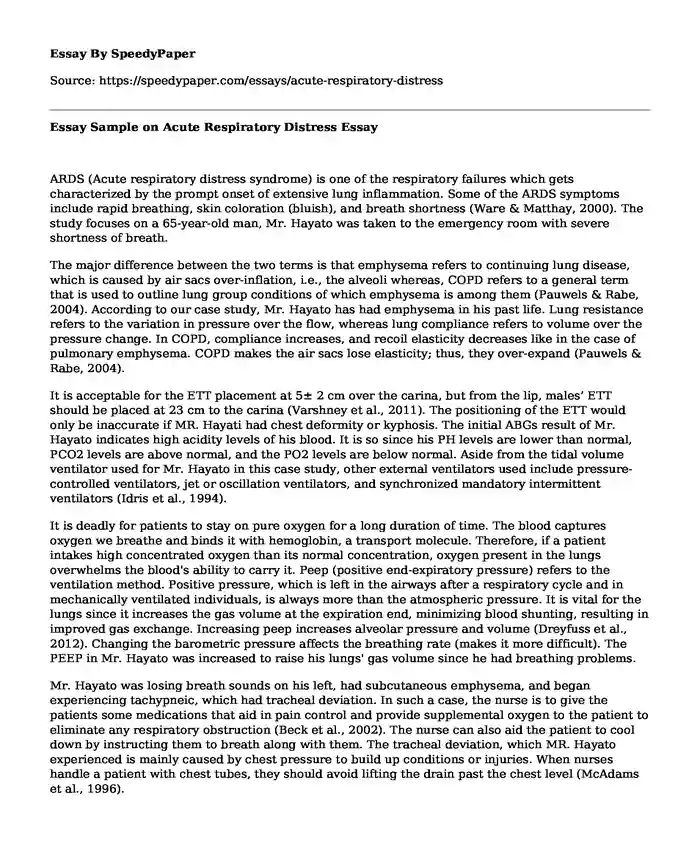ARDS (Acute respiratory distress syndrome) is one of the respiratory failures which gets characterized by the prompt onset of extensive lung inflammation. Some of the ARDS symptoms include rapid breathing, skin coloration (bluish), and breath shortness (Ware & Matthay, 2000). The study focuses on a 65-year-old man, Mr. Hayato was taken to the emergency room with severe shortness of breath.
The major difference between the two terms is that emphysema refers to continuing lung disease, which is caused by air sacs over-inflation, i.e., the alveoli whereas, COPD refers to a general term that is used to outline lung group conditions of which emphysema is among them (Pauwels & Rabe, 2004). According to our case study, Mr. Hayato has had emphysema in his past life. Lung resistance refers to the variation in pressure over the flow, whereas lung compliance refers to volume over the pressure change. In COPD, compliance increases, and recoil elasticity decreases like in the case of pulmonary emphysema. COPD makes the air sacs lose elasticity; thus, they over-expand (Pauwels & Rabe, 2004).
It is acceptable for the ETT placement at 5± 2 cm over the carina, but from the lip, males’ ETT should be placed at 23 cm to the carina (Varshney et al., 2011). The positioning of the ETT would only be inaccurate if MR. Hayati had chest deformity or kyphosis. The initial ABGs result of Mr. Hayato indicates high acidity levels of his blood. It is so since his PH levels are lower than normal, PCO2 levels are above normal, and the PO2 levels are below normal. Aside from the tidal volume ventilator used for Mr. Hayato in this case study, other external ventilators used include pressure-controlled ventilators, jet or oscillation ventilators, and synchronized mandatory intermittent ventilators (Idris et al., 1994).
It is deadly for patients to stay on pure oxygen for a long duration of time. The blood captures oxygen we breathe and binds it with hemoglobin, a transport molecule. Therefore, if a patient intakes high concentrated oxygen than its normal concentration, oxygen present in the lungs overwhelms the blood's ability to carry it. Peep (positive end-expiratory pressure) refers to the ventilation method. Positive pressure, which is left in the airways after a respiratory cycle and in mechanically ventilated individuals, is always more than the atmospheric pressure. It is vital for the lungs since it increases the gas volume at the expiration end, minimizing blood shunting, resulting in improved gas exchange. Increasing peep increases alveolar pressure and volume (Dreyfuss et al., 2012). Changing the barometric pressure affects the breathing rate (makes it more difficult). The PEEP in Mr. Hayato was increased to raise his lungs' gas volume since he had breathing problems.
Mr. Hayato was losing breath sounds on his left, had subcutaneous emphysema, and began experiencing tachypneic, which had tracheal deviation. In such a case, the nurse is to give the patients some medications that aid in pain control and provide supplemental oxygen to the patient to eliminate any respiratory obstruction (Beck et al., 2002). The nurse can also aid the patient to cool down by instructing them to breath along with them. The tracheal deviation, which MR. Hayato experienced is mainly caused by chest pressure to build up conditions or injuries. When nurses handle a patient with chest tubes, they should avoid lifting the drain past the chest level (McAdams et al., 1996).
Subcutaneous emphysema refers to a condition that results when air enters the tissues under the skin. It mostly occurs in the neck or chest wall skin covering. In our case, Mr. Hayato experienced subcutaneous emphysema, which caused breathing abnormalities. In this case, the nurse can allow him to take bed rest, give him medication to control the pain, or supplement oxygen (Beck et al., 2002). Subcutaneous emphysema is typically not a serious condition, but some caution should be taken since it can imply a serious condition.
References
Beck, P. L., Heitman, S. J., & Mody, C. H. (2002). The simple construction of a subcutaneous catheter for treatment of severe subcutaneous emphysema. Chest, 121(2), 647-649. https://www.researchgate.net/profile/Christopher_Mody/publication/11525524_Simple_construction_of_a_subcutaneous_catheter_for_treatment_of_severe_subcutaneous_emphysema/links/0deec52d5a0fd633a0000000.pdf
Dreyfuss, D., Soler, P., Basset, G., & Saumon, G. (2012). High inflation pressure pulmonary edema: Respective effects of high airway pressure, high tidal volume, and positive end-expiratory pressure. American Review of Respiratory Disease. https://www.atsjournals.org/doi/full/10.1164/ajrccm/137.5.1159
Idris, A. H., Banner, M. J., Wenzel, V., Fuerst, R. S., Becker, L. B., & Melker, R. J. (1994). Ventilation caused by external chest compression cannot sustain effective gas exchange during CPR: a comparison with mechanical ventilation. Resuscitation, 28(2), 143-150. https://www.resuscitationjournal.com/article/0300-9572(94)90087-6/fulltext
McAdams, H. P., Gordon, D. S., & White, C. S. (1996). Apical lung hernia: radiologic findings in six cases. AJR. American Journal of roentgenology, 167(4), 927-930. https://www.researchgate.net/profile/Holman_Mcadams/publication/14386717_Apical_lung_hernia_Radiologic_findings_in_six_cases/links/564dc3f508aefe619b0e1782.pdf
Pauwels, R. A., & Rabe, K. F. (2004). Burden and clinical features of chronic obstructive pulmonary disease (COPD). The Lancet, 364(9434), 613-620. https://www.lumc.nl/sub/1070/att/91028021319455/100317001646452.pdf
Varshney, M., Sharma, K., Kumar, R., & Varshney, P. G. (2011). The appropriate depth of placement of oral endotracheal tube and its possible determinants in Indian adult patients. Indian Journal of Anaesthesia, 55(5), 488. https://www.ncbi.nlm.nih.gov/pmc/articles/PMC3237149/
Ware, L. B., & Matthay, M. A. (2000). The acute respiratory distress syndrome. New England Journal of Medicine, 342(18), 1334-1349. https://www.nejm.org/doi/full/10.1056/NEJM200005043421806
Cite this page
Essay Sample on Acute Respiratory Distress. (2023, Oct 09). Retrieved from https://speedypaper.com/essays/acute-respiratory-distress
Request Removal
If you are the original author of this essay and no longer wish to have it published on the SpeedyPaper website, please click below to request its removal:
- Free Essay: Exposure Routes and Health Effects of Heavy Metals on Children
- Tissue Family Reunion - Free Essay
- Free Essay - Final Care Coordination Plan
- Paper Example: Experimental Versus Observational Study
- Legalizing Medical and Recreational Marijuana Increases Drug Use: Reflection Example
- Psychology: Pharmacotherapy and Pharmacokinetics - Free Paper Sample
- Essay Sample on Why Fast Foods Should Be Outlawed
Popular categories





